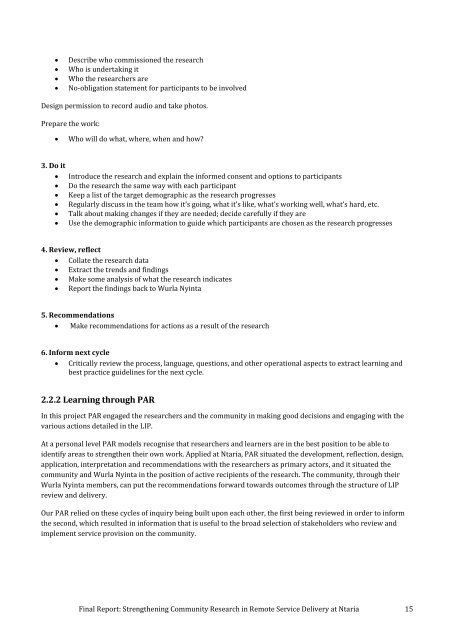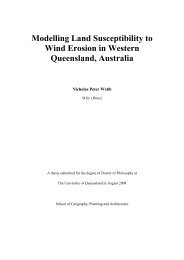Final Report: Strengthening Community Research in ... - Ninti One
Final Report: Strengthening Community Research in ... - Ninti One
Final Report: Strengthening Community Research in ... - Ninti One
Create successful ePaper yourself
Turn your PDF publications into a flip-book with our unique Google optimized e-Paper software.
Describe who commissioned the researchWho is undertak<strong>in</strong>g itWho the researchers areNo-obligation statement for participants to be <strong>in</strong>volvedDesign permission to record audio and take photos.Prepare the work:Who will do what, where, when and how?3. Do it Introduce the research and expla<strong>in</strong> the <strong>in</strong>formed consent and options to participants Do the research the same way with each participant Keep a list of the target demographic as the research progresses Regularly discuss <strong>in</strong> the team how it’s go<strong>in</strong>g, what it’s like, what’s work<strong>in</strong>g well, what’s hard, etc. Talk about mak<strong>in</strong>g changes if they are needed; decide carefully if they are Use the demographic <strong>in</strong>formation to guide which participants are chosen as the research progresses4. Review, reflect Collate the research data Extract the trends and f<strong>in</strong>d<strong>in</strong>gs Make some analysis of what the research <strong>in</strong>dicates <strong>Report</strong> the f<strong>in</strong>d<strong>in</strong>gs back to Wurla Ny<strong>in</strong>ta5. Recommendations Make recommendations for actions as a result of the research6. Inform next cycle Critically review the process, language, questions, and other operational aspects to extract learn<strong>in</strong>g andbest practice guidel<strong>in</strong>es for the next cycle.2.2.2 Learn<strong>in</strong>g through PARIn this project PAR engaged the researchers and the community <strong>in</strong> mak<strong>in</strong>g good decisions and engag<strong>in</strong>g with thevarious actions detailed <strong>in</strong> the LIP.At a personal level PAR models recognise that researchers and learners are <strong>in</strong> the best position to be able toidentify areas to strengthen their own work. Applied at Ntaria, PAR situated the development, reflection, design,application, <strong>in</strong>terpretation and recommendations with the researchers as primary actors, and it situated thecommunity and Wurla Ny<strong>in</strong>ta <strong>in</strong> the position of active recipients of the research. The community, through theirWurla Ny<strong>in</strong>ta members, can put the recommendations forward towards outcomes through the structure of LIPreview and delivery.Our PAR relied on these cycles of <strong>in</strong>quiry be<strong>in</strong>g built upon each other, the first be<strong>in</strong>g reviewed <strong>in</strong> order to <strong>in</strong>formthe second, which resulted <strong>in</strong> <strong>in</strong>formation that is useful to the broad selection of stakeholders who review andimplement service provision on the community.<strong>F<strong>in</strong>al</strong> <strong>Report</strong>: <strong>Strengthen<strong>in</strong>g</strong> <strong>Community</strong> <strong>Research</strong> <strong>in</strong> Remote Service Delivery at Ntaria 15
















